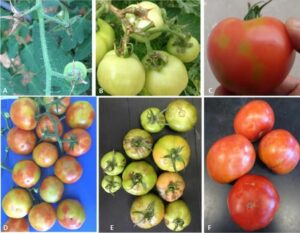Virus-Infected Tomatoes May Be Prevalent at Grocery Stores
go.ncsu.edu/readext?993768
en Español / em Português
El inglés es el idioma de control de esta página. En la medida en que haya algún conflicto entre la traducción al inglés y la traducción, el inglés prevalece.
Al hacer clic en el enlace de traducción se activa un servicio de traducción gratuito para convertir la página al español. Al igual que con cualquier traducción por Internet, la conversión no es sensible al contexto y puede que no traduzca el texto en su significado original. NC State Extension no garantiza la exactitud del texto traducido. Por favor, tenga en cuenta que algunas aplicaciones y/o servicios pueden no funcionar como se espera cuando se traducen.
Português
Inglês é o idioma de controle desta página. Na medida que haja algum conflito entre o texto original em Inglês e a tradução, o Inglês prevalece.
Ao clicar no link de tradução, um serviço gratuito de tradução será ativado para converter a página para o Português. Como em qualquer tradução pela internet, a conversão não é sensivel ao contexto e pode não ocorrer a tradução para o significado orginal. O serviço de Extensão da Carolina do Norte (NC State Extension) não garante a exatidão do texto traduzido. Por favor, observe que algumas funções ou serviços podem não funcionar como esperado após a tradução.
English
English is the controlling language of this page. To the extent there is any conflict between the English text and the translation, English controls.
Clicking on the translation link activates a free translation service to convert the page to Spanish. As with any Internet translation, the conversion is not context-sensitive and may not translate the text to its original meaning. NC State Extension does not guarantee the accuracy of the translated text. Please note that some applications and/or services may not function as expected when translated.
Collapse ▲A recent study from the University of Florida discovered high incidences of two tomato viruses (ToBRFV and PepMV) in tomato fruit among 10 grocery stores surveyed in Florida. Tomato brown rugose fruit virus (ToBRFV) and pepino mosaic virus (PepMV) were found in more than 70% of fruits sampled and often were both detected in the same fruit (see figure below for details) and this scenario presents a pathway for these viruses to enter our crop production systems. Fruit that were sampled had originated in Mexico, Canada or the United States.
Therefore, anyone who works with tomatoes and other solanaceous crops (growers, agents, agronomists, crop consultants, researchers, etc.) is advised to avoid touching, handling, or purchasing tomato fruit that are mottled, discolored, unevenly ripening, and/or have rough texture to avoid potentially introducing unwanted viruses to our cropping systems.
Although these viruses are in different virus groups, both can be mechanically transmitted meaning that sap from infected plant parts, including fruit, can be transmitted to a healthy plant by touching. Both are economically important viruses that have caused global epidemics.

Symptoms of ToBRFV on tomato plants and fruit. Credit: A. Dombrovsky, O. Batuman, Fidan et al. (2019) and Luria et al. (2017),

The percent distribution of tomato brown rugose fruit virus (ToBRFV) and pepino mosaic
virus (PepMV) and their co-infection in tomatoes imported from Canada, Mexico, and the United
States. (The origin of the tomatoes was determined based on the package labels). From Yilmaz and Batuman, 2023,
PepMV has already been established in the US and although ToBRFV is still regulated by USDA-APHIS as of the date of this publication, it is thought that this virus is likely already in our cropping systems given that it can be detected in fruit in grocery stores and in wastewater systems based on publications by Serchan et al. (2023) and Rothman and Whiteson (2022).
If you suspect disease on your crop, please contact your local extension agent, agronomist (for commercial growers only), or send samples to the NC State Plant Disease and Insect Clinic.



